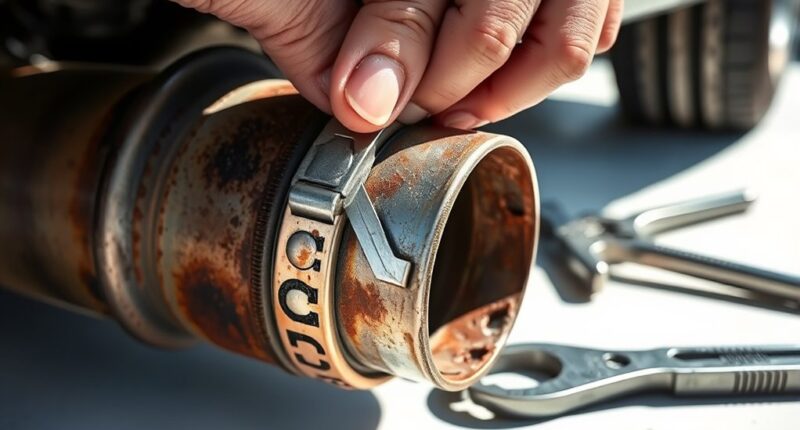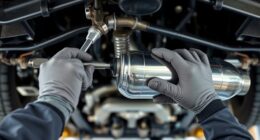To fix an exhaust leak without a lift, start by inspecting the system for visible cracks, holes, or rust, listening for hissing sounds. Use common tools like a wrench and screwdriver to access the area. Apply high-temperature sealant or repair tape to small leaks as a quick solution. For larger gaps, consider welding or replacing the damaged sections. Keep safety in mind and guarantee the vehicle’s cool—more tips await if you look closer.
Key Takeaways
- Locate the leak by listening for hissing sounds and visually inspecting for soot or rust around seams.
- Use simple tools like a wrench and screwdriver to access the affected exhaust area safely.
- Apply high-temperature sealant or repair tape directly to small cracks or holes for a quick fix.
- Ensure the vehicle is cool before working, and cure the sealant fully before starting the engine.
- For larger leaks, consider replacing or welding the damaged section, or seek professional help if needed.

Fixing an exhaust leak can be a straightforward process that doesn’t require a lift or complex tools. Start by identifying the exact location of the leak, often heard as a hissing or popping sound, or visible as rust or soot around seams and joints. Once located, you can use simple tools like a wrench, screwdriver, and high-temperature sealant or repair tape to seal small cracks or holes. For larger gaps, welding or replacing sections of the exhaust pipe may be necessary, but for minor leaks, a temporary fix with sealant can suffice until a proper repair is made. Remember to ensure the vehicle is cool before working on the exhaust system to avoid burns. Regular inspection and maintenance of your exhaust system help prevent leaks and maintain optimal vehicle performance. Additionally, understanding exhaust system components can help in accurately diagnosing issues and applying the appropriate fix.
Frequently Asked Questions
Can I Fix an Exhaust Leak on a Motorcycle the Same Way?
You can often fix a motorcycle exhaust leak the same way as a car exhaust, but it depends on the leak’s location and severity. For small leaks, you might try sealing it with high-temperature epoxy or exhaust repair tape. However, always guarantee you use proper tools and safety gear. If the leak is large or near critical components, consider professional repair to avoid further damage or safety hazards.
How Long Does a DIY Exhaust Leak Repair Typically Last?
Think of your DIY exhaust leak repair like a well-made sandwich—it can last quite a while if done right. Typically, it offers durability expectations of several months to a year, depending on your riding conditions and maintenance tips. To extend its lifespan, regularly check for leaks, keep the area clean, and avoid harsh weather. With proper care, your repair can be reliable and save you money in the long run.
Is It Safe to Drive Immediately After Fixing the Leak?
You might wonder if it’s safe to drive immediately after fixing an exhaust leak. Generally, it’s best to follow safety precautions and wait until your repair is fully cooled before driving. Conduct an inspection checklist to guarantee all connections are tight and no leaks remain. If everything looks good, you should be safe to drive, but always double-check for any unusual noises or fumes before hitting the road.
What Are the Signs That a Repair Was Unsuccessful?
Ever wondered if your fix worked? If you notice an exhaust smell lingering or a persistent noise from under your vehicle, your repair might be unsuccessful. These signs indicate leaks or improper sealing. You should also check for unusual vibrations or smoke. If these issues persist after your repair, it’s best to revisit the fix or consult a professional. Don’t ignore these signs—they’re your vehicle’s way of telling you something’s still wrong.
Can I Use This Method on Rusted or Severely Damaged Exhausts?
You can try this method on rusted joints or severely damaged pipes, but it might not be effective. Rusted joints often need more extensive cleaning or replacement, and severely damaged pipes may require professional repairs or full replacement. If your exhaust is heavily corroded or cracked, using simple tools won’t provide a reliable fix, and you should consider consulting a mechanic to guarantee safety and proper function.
Conclusion
So, it’s pretty amazing how a simple fix can save you time and money, isn’t it? Sometimes, just a few basic tools and a bit of patience can make all the difference—who knew that fixing an exhaust leak could be so straightforward? Next time you hear that rattling or smell something off, remember, you might just stumble upon a quick fix that’s right under your nose. It’s almost like the universe’s little coincidence!










